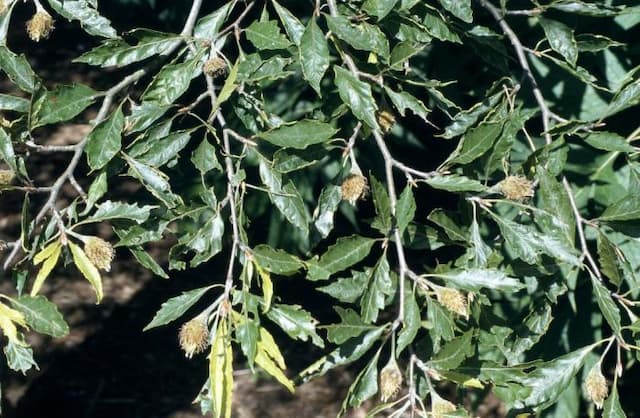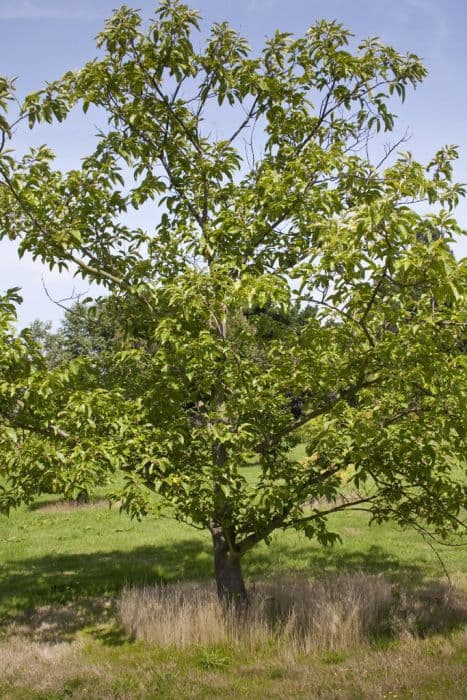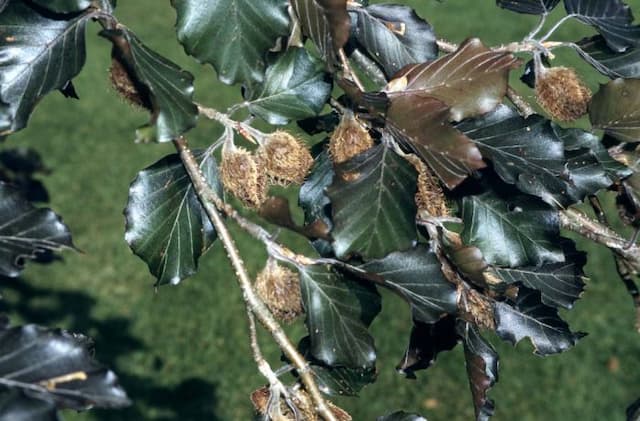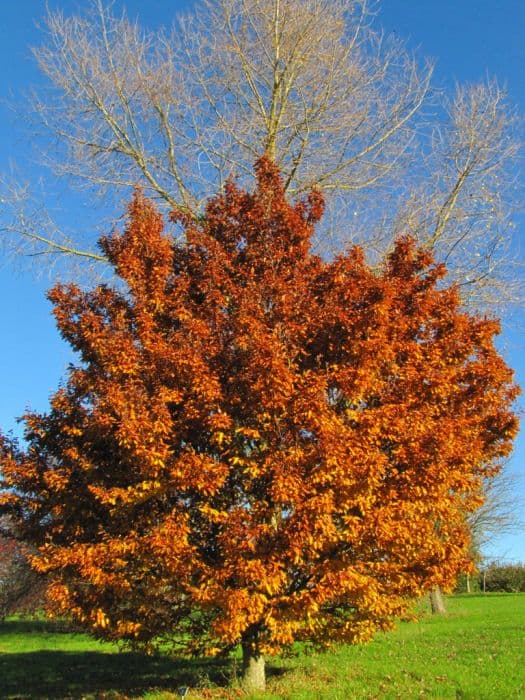European Beech Fagus sylvatica 'Dawyck Purple'

ABOUT
The 'Dawyck Purple' is a variety of European beech known for its striking appearance. It features a narrow, upright growth habit that creates a stately, columnar form. The defining feature of this plant is its rich purple leaves, which capture the eye with their deep, burgundy hue. These leaves are glossy and typically oval in shape, coming to a point at the tip, which makes the foliage quite elegant. In autumn, the purple fades to a coppery color, offering a beautiful seasonal transition before the leaves fall. The bark of the 'Dawyck Purple' is smooth, with a silvery-grey color that contrasts nicely against the dark foliage. This plant is commonly appreciated for its ornamental qualities and its ability to provide a vertical accent in landscape designs.
About this plant
 Names
NamesSynonyms
Dawyck Purple Beech, Purple European Beech, Purple Fountain Beech, Dawyck Purple European Beech.
Common names
Fagus sylvatica 'Dawyck Purple'.
 Toxicity
ToxicityTo humans
The European beech, specifically the Fagus sylvatica 'Dawyck Purple', is not considered highly toxic to humans. However, consuming parts of this plant, especially in large quantities, can potentially cause stomach upset or digestive discomfort. No severe symptoms of poisoning are generally reported from ingesting parts of the European beech.
To pets
The European beech is not commonly listed as a toxic plant to pets such as dogs and cats. There is no well-documented case of poisoning in pets from ingesting this plant. However, like many other non-food plants, ingestion of large amounts might result in mild gastrointestinal discomfort or illness, so it is still advisable to prevent pets from consuming this plant.
 Characteristics
CharacteristicsLife cycle
Perennials
Foliage type
Deciduous
Color of leaves
Purple
Height
50 feet (15 meters)
Spread
10 feet (3 meters)
Plant type
Tree
Hardiness zones
4-7
Native area
Europe
Benefits
 General Benefits
General Benefits- Aesthetic Appeal: The Dawyck Purple Beech's distinctive purple foliage provides a dramatic visual impact in landscapes.
- Seasonal Interest: This beech features striking seasonal changes, from purplish new leaves in spring to deep burgundy in summer and copper-toned leaves in fall.
- Architectural Form: With its columnar growth habit, the Dawyck Purple Beech makes a strong vertical statement, which can be used to enhance architectural designs.
- Shade Provider: Mature trees create dense canopies that offer substantial shade in gardens and parks.
- Wildlife Habitat: The tree provides a habitat and food source for various birds and small mammals through its nuts and sheltering foliage.
- Durability: The Dawyck Purple Beech is known for its hardiness and can tolerate a variety of soil conditions, although it prefers well-drained soils.
- Low Maintenance: Once established, this tree requires minimal care and is relatively free from major pest and disease problems.
- Longevity: Beech trees are known for their long lifespan, providing benefits to an area for generations.
- Privacy Screen: When planted in a row, these trees can form an effective natural screen, enhancing privacy and reducing noise pollution.
- Seasonal Wildlife Support: In addition to providing year-round habitat, the tree's nuts are an important food source for wildlife in the autumn months.
 Medical Properties
Medical PropertiesThis plant is not used for medical purposes.
 Air-purifying Qualities
Air-purifying QualitiesThis plant is not specifically known for air purifying qualities.
 Other Uses
Other Uses- Woodworking: The wood of the European beech can be used for creating fine furniture and decorative objects due to its hardness and fine grain.
- Musical instruments: Because of its tonal qualities, the wood can be crafted into parts for musical instruments such as piano actions and drum shells.
- Flooring: European beech wood is desirable for use in high-quality flooring materials for its durability and attractive appearance.
- Turned objects: The wood turns well on a lathe, making it suitable for producing decorative bowls, spindles, and other turned items.
- Smoking food: Beech wood chips are commonly used for smoking meats and cheeses, imparting a mild and slightly sweet flavor.
- Craft veneers: The tree's wood can be sliced into thin sheets to create veneers for cabinetry, paneling, and marquetry.
- Dye production: Historically, the leaves of the beech tree have been used to produce a green dye.
- Artistic inspiration: The distinctive purple foliage of 'Dawyck Purple' can be a subject or inspiration for artists, particularly in autumn.
- Sound barriers: The dense foliage and growth habit make these trees effective as sound barriers when planted in rows along highways or property lines.
- Bonsai: Some enthusiasts use European beech for creating bonsai trees due to their ability to respond well to pruning and to form miniaturized leaves.
Interesting Facts
 Feng Shui
Feng ShuiThe European Beech is not used in Feng Shui practice.
 Zodiac Sign Compitability
Zodiac Sign CompitabilityThe European Beech is not used in astrology practice.
 Plant Symbolism
Plant Symbolism- Stability and Strength: As a variety of beech tree, the Dawyck Purple European Beech represents stability and strength due to its solid and sturdy trunk.
- Knowledge and Wisdom: Beech trees are often associated with knowledge and wisdom, possibly because of their long lifespan and the old practice of using beech wood to create writing tablets.
- Patience and Tolerance: The slow growth of the Dawyck Purple European Beech symbolizes patience and the capacity for tolerance, embodying the idea of measured and thoughtful development.
- Nobility and Majesty: With its majestic purple foliage, this tree is frequently linked to nobility and is thought to add a regal touch to the landscapes in which it's planted.
- Longevity: Since beech trees can live for hundreds of years, they are often associated with longevity and the passage of time.
- Solitude: The tall and narrow form of the Dawyck Purple European Beech can evoke feelings of solitude or reflect the beauty of standing tall and distinguished.
 Water
WaterFor the European beech or 'Dawyck Purple', it's essential to maintain a consistent watering schedule, especially during the first few years after planting to establish a strong root system. Water the tree deeply, applying about 15 to 20 gallons per week during the growing season. In times of drought, increase the water to twice a week, ensuring the soil is moist but not waterlogged. During the winter months, reduce watering since the tree is dormant and the water uptake is much lower. Avoid overhead watering to prevent the leaves from developing fungal diseases.
 Light
LightEuropean beech trees such as 'Dawyck Purple' prefer full sun to partial shade conditions for optimal growth. An ideal spot would expose the tree to direct sunlight for at least six hours a day while providing some shade during the hottest part of the day to protect the leaves from scorching. These trees thrive in a location that is sheltered from strong winds.
 Temperature
TemperatureThe 'Dawyck Purple' European beech tree is hardy and can tolerate a range of temperatures. It can survive winter temperatures as low as -20°F and is comfortable in the summer heat up to 95°F. Ideally, the tree prefers to grow in temperate conditions where the temperature does not fluctuate drastically. Sudden extreme cold or heat can negatively impact the tree.
 Pruning
PruningPruning the 'Dawyck Purple' European beech is generally done to shape the tree, remove any dead or diseased wood, and promote overall health. The best time for pruning is during late winter or early spring before new growth starts. Prune sparingly as European beech trees heal slowly, and excessive cutting can lead to dieback or disease entrance. Annual light pruning is generally sufficient.
 Cleaning
CleaningNot needed
 Soil
SoilEuropean Beech 'Dawyck Purple' thrives in well-draining, fertile soil with a pH of 5.0 to 6.0. A mix of loamy soil, compost, and sand can ensure proper drainage and nutrient content.
 Repotting
RepottingThe European Beech 'Dawyck Purple' should be planted in the landscape rather than potted, so repotting is not applicable as it is a tree.
 Humidity & Misting
Humidity & MistingEuropean Beech 'Dawyck Purple' prefers moderate humidity levels but is adaptable to various outdoor conditions as it is a hardy tree.
 Suitable locations
Suitable locationsIndoor
Cannot grow 'Dawyck Purple' beech indoors; it's a large outdoor tree.
Outdoor
Plant in well-drained soil, full sun to partial shade; it's a landscape tree.
Hardiness zone
Zones 4-7 USDA.
 Life cycle
Life cycleThe life cycle of the European Beech 'Dawyck Purple' starts with seed germination, wherein the stratified seeds will sprout under appropriate temperature and moisture conditions. After germination, the seedling grows through a juvenile phase where it establishes roots and begins to develop its characteristic purple foliage. As it enters the sapling stage, the tree gradually matures and the trunk thickens, growing taller and more robust over several years. The mature European Beech 'Dawyck Purple' reaches its reproductive stage, producing flowers that are wind-pollinated, leading to the development of beechnuts, which are the tree's seeds. This stage can continue for many years as the tree enters a phase of sustained growth and reproduction. Eventually, the tree enters senescence, characterized by a decline in vitality and productivity until it dies, completing its life cycle.
 Propogation
PropogationPropogation time
Late Winter-Early Spring
The European Beech 'Dawyck Purple' is typically propagated through grafted cuttings, which is the most popular method for this species. This technique involves taking a healthy cutting from a mature 'Dawyck Purple' beech, which generally happens in late winter or early spring when the plant is still dormant. The cutting should include at least one bud and be about 6 to 8 inches (15 to 20 centimeters) in length. The bottom end of the cutting is then grafted onto a rootstock of another beech tree. This process, known as whip and tongue grafting, requires precise cuts on both the rootstock and the scion - the cutting from the 'Dawyck Purple' - so that the two parts can be tightly joined and will grow together. The graft is then wrapped with grafting tape or a similar material to hold the joint in place and protect it until the graft has healed and the scion has established itself, which can take several months.









